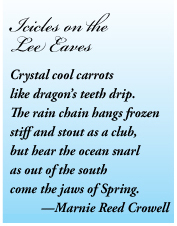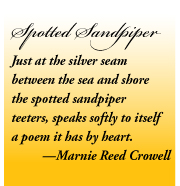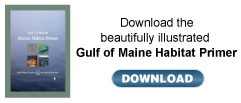Profile: Marnie Reed Crowell
Waxing poetic on the spring melt, lichens and all things natural
By Lori Valigra
Nothing tickles Marnie Reed Crowell’s imagination like
the spring melt. At the first signs of cracking ice, birds returning
from their winter retreats and buds clustering on branches, images
flood her mind and poetry runs through her fingertips onto paper.
The biologist-cum-poet and environment conservationist says every
season has its charms, but she loves melt. “I like to watch
new sprouts come up and the old, dirty snow melt away,” she
said excitedly. “And then I like to see which things are
on time. It’s a bit of detective work.” Some birds always
return on time, triggered by daylight. “Increasing day is
a metaphor for optimism,” said Crowell.

 Crowell, a Deer Isle, Maine, resident originally from New Jersey,
doesn’t see the line often drawn between science and artistic
expression. The daughter of an entomologist, she grew up fascinated
with the natural world. She fell in love with both words and science,
and to this day still hasn’t chosen between them. And like
her father, she possesses a natural curiosity about the things
she doesn’t know in nature, and an unstoppable willingness
to share what she does know with anyone within earshot. “I
grew up explaining how an entomologist was insects and
an etymologist was words,” she said. “My father
taught me the scientific and the common name for everything we
saw. I had a hard time choosing between arts and science.”
Ultimately, she didn’t choose, but wove the two together,
teaching high school biology and Latin. Crowell has since published
a number of books on natural history as well as poetry. “I
called my first book Greener Pastures because I thought
any pasture is worth greening,” she said. Perhaps some of
the inspiration for that book came from teaching biology to inner-city
sophomores in Camden, New Jersey, who didn’t spend much time
getting to know the natural world around them. “As far as
they were concerned, a little brown bird was a kind of bird. That
was a bird species.” Crowell, a Deer Isle, Maine, resident originally from New Jersey,
doesn’t see the line often drawn between science and artistic
expression. The daughter of an entomologist, she grew up fascinated
with the natural world. She fell in love with both words and science,
and to this day still hasn’t chosen between them. And like
her father, she possesses a natural curiosity about the things
she doesn’t know in nature, and an unstoppable willingness
to share what she does know with anyone within earshot. “I
grew up explaining how an entomologist was insects and
an etymologist was words,” she said. “My father
taught me the scientific and the common name for everything we
saw. I had a hard time choosing between arts and science.”
Ultimately, she didn’t choose, but wove the two together,
teaching high school biology and Latin. Crowell has since published
a number of books on natural history as well as poetry. “I
called my first book Greener Pastures because I thought
any pasture is worth greening,” she said. Perhaps some of
the inspiration for that book came from teaching biology to inner-city
sophomores in Camden, New Jersey, who didn’t spend much time
getting to know the natural world around them. “As far as
they were concerned, a little brown bird was a kind of bird. That
was a bird species.”
Wild times in the city
Crowell believes anyone can sensitize themselves to nature, starting
with small steps. For example, city dwellers could notice the
subtler signs of spring’s onset by seeing the discoloration
at the bottom of a tree. If they’re inquisitive, they might
look beyond what most would call “scum” and consult
a guide book at their local library. In the book they’d discover
they had seen one of the two or so lichens that can survive city
air pollution. Country dwellers may be able to identify 30 species
of lichens on trees where the air is purer, she said. But merely
noticing that there is something growing on the tree is a step
closer to nature. “You may not be able to name them [the
lichens], but you’re a step ahead of yesterday when you didn’t
know they were there,” she effused. “So the world just
keeps getting richer and richer.”
|
 |
|
Nowadays, Crowell, keen-eyed and energetic at 69, explores
Deer Isle, where she puts her astute and sensitive observations
and interactions with nature into verse that even the most science-challenged
can understand. Working at her side much of the time is photographer
Ann Flewelling, who brings the dimension of physical imagery to
the stanzas of her poems. The two call their verbal/visual collaboration
“threehalf press,” because the combination of one plus
one person can be more than two. Their most recent book, Beads
& String: A Maine Island Pilgrimage, is a collaboration
that highlights Deer Isle’s preserves. New chapters focused
on months of the year appear each month on the Web site of Island Heritage Trust, a conservation
land trust for Deer Isle, Stonington and the surrounding islands.
Proceeds for the book, to be published in full in the spring,
will go to the Trust.
A trust emerges
The volunteer-run Island Heritage Trust is another of Crowell’s
loves. She and her husband, Ken, an ecologist, were instrumental
in its origins in 1987. It was Ken’s work studying the mouse
populations on different islands surrounding Deer Isle that helped
enlarge the circle of people interested in donating land or easements
to maintain the pristine character of Deer Isle. Crowell said
it’s not necessary to be a Rockefeller to donate land or
services, such as the proceeds of a book, to a land trust. “No
one was a millionaire on Deer Isle,” she said. She and Ken
met many islanders through Ken’s work. They also volunteered
to give nature walks and talks, which inspired other islanders
who attended to donate land or easements to the Trust.
Their interest in conservation began in New Jersey, where both
are from, and where they got involved in The Nature Conservancy,
which later led to their work in the land trust. Of Deer Isle’s
24,000 acres (9,712 hectares), so far 2-3 percent are preserved.
Hear Marie read her poem "Dowsing" click to play click to play
Crowell, her husband and their Deer Isle friends started the
land trust. What is amazing about Deer Isle, Crowell said, is
that almost all of the preserves in the early years were gifts
from people. “Nobody was wealthy. Emily Muir had to sell
some of her land so she could afford to give away that other land,”
said Crowell of local builder, architect and artist Muir, who
decided to give the backland where she was building a line of
houses along a cove as a nature preserve.
Crowell admitted those were good years, but now people considering
making donations have a tougher decision with the rapid escalation
of land prices. “Land preservation is entering a new phase,”
she said. “How do you deal when you’re now talking millions
of dollars? The last couple of years the preserves have been purchased,
not given. People may be generous, but they’re not going
to give away a million-dollar nest egg.”
But there are smaller, still important contributions that can
be made. “Most of my contribution has been I donated my talent,”
she said. ”It happens we came to Deer Isle early on, so we
were able to acquire 30 acres (12 hectares) of land that’s
right next to a preserve. We gave the conservation easement on
it.”
But Crowell feels her more significant contribution to the
land trust has been reaching the local people through nature walks
and books, work that inspired the people who owned properties
to find a good mechanism to donate. “That’s totally
satisfying,” she said.

Artists as educators
So what is the artist’s role in preserving the environment?
“An editor at Reader’s Digest told me the key
to success is that people want to know what it’s like to
be inside someone else’s skin. So I’ll tell you what
it’s like to be me and go mackerel fishing.” Crowell
doesn’t think artists are obligated to have an environmental
cause or bend to their work, but she does suggest to her artist
friends that making an artist’s statement could be useful.
Crowell said most of the local artists do make such a statement,
for example, Carolyn Caldwell. “Why do I paint?” she
says in her artist’s statement on her Web site. “Vanishing beauty. The world
is changing rapidly. Development is overtaking the natural world….My
hope is that artists can slow the rush.”
Said Crowell, “She could have painted ugly stuff, but
she chose to paint beautiful stuff and serenity and say, ‘look,
if we don’t take care of it, this is what we’re going
to lose.’”
It’s not just professional painters, photographers or
writers who can speak for the environment. Crowell admits she
wasn’t trained to write. She felt compelled to do so. She
also hails the advent of new technologies like digital cameras,
which make it easy for people to capture and share images via
home-made newsletters, the Internet and other ways.

Hear Marie read her poem "Spotted Sandpiper" click to play click to play
“If you’re a city person looking at ants and then
go to the museum and look at the display, how do you share that?
Do you share it in your local co-op newsletter? Do you share it
in your school newspaper? You probably can find someplace to share
it, and it probably will mean something to other people,”
she said. “Part of what I do, by the way Dowsing and
other poems, is for people who spend their life’s energy
in a city working hard. They need their battery recharged,”
she added. “So by reading Dowsing they’ll feel
better, like holding hands with wind on the bay.”
 Crowell recommends carrying around a small notebook, or jotting
creative thoughts, phrases and inspirations on them. “I had
to learn to trust my own flash of emotion or inspiration,”
she said. “What I see in the natural world is usually a metaphor
that has a deeper meaning to me. It is a highly spiritual experience,
like Dowsing or Mackerel. Both of those poems are
pretty humbling. Like Dowsing. I literally was walking
around the Isle with a stick in my hand and Ann looked at me and
said you’re doing a poem aren’t you? And I said I suppose
I am. What is the poem about? It’s about holding these sticks
in your hand. Formerly bayberry, these are ordinary twigs, but
I like the way they feel in my hand. I’m half expecting them
to pull down toward the center of the earth like a dowser. And
then I realize this is so interesting it must be the way a lobster
feels in communion with something bigger and since it’s sea
you’d call it Neptune or Poseidon.” Crowell recommends carrying around a small notebook, or jotting
creative thoughts, phrases and inspirations on them. “I had
to learn to trust my own flash of emotion or inspiration,”
she said. “What I see in the natural world is usually a metaphor
that has a deeper meaning to me. It is a highly spiritual experience,
like Dowsing or Mackerel. Both of those poems are
pretty humbling. Like Dowsing. I literally was walking
around the Isle with a stick in my hand and Ann looked at me and
said you’re doing a poem aren’t you? And I said I suppose
I am. What is the poem about? It’s about holding these sticks
in your hand. Formerly bayberry, these are ordinary twigs, but
I like the way they feel in my hand. I’m half expecting them
to pull down toward the center of the earth like a dowser. And
then I realize this is so interesting it must be the way a lobster
feels in communion with something bigger and since it’s sea
you’d call it Neptune or Poseidon.”
She added, “What I would encourage everybody to do is
when you get those thoughts, work on them, play with them, make
them more exact and meaningful. Words have an abstract melody.
Listen to that. You don’t need to go to a poetry class. Allow
yourself to listen to it as an abstract sound. And the pattern
of words that most fit, play with that for a week or so and look
at it again. A better way of arranging it will occur to you. That
tinkering is what’s making poems.”
Lori Valigra is editor of the Gulf of Maine Times.
For more of Marnie Reed Crowell’s and Ann Flewelling’s
work visit: http://www.threehalfpress.com.
|








